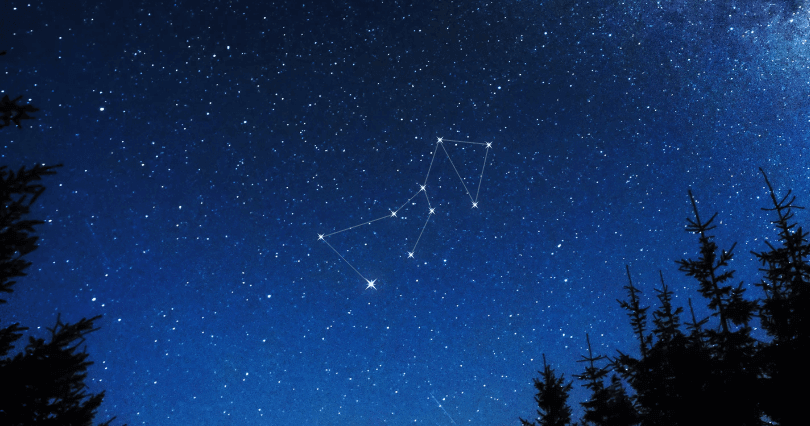Lupus Constellation

Lupus constellation is located in the southern hemisphere. It lies right between Zodiac constellation Scorpius and Centaurus. The name Lupus is Latin and it means the wolf. Lupus constellation was first spotted by famous Greek astronomer Ptolemy in the 2nd century BC and cataloged in his 48 then-known constellations list. Lupus constellation is now known to be one of the 88 modern constellations, listed and recognized by the International Astrological Union. Although this constellation has a long history it is not connected to any Greek-Roman myths.
There is however one story from the mythology in which was thought that Lupus represents the wild African dog of Arcadian’s first King. The stars that form its asterism look like some type of creature – Ptolemy described it as some kind of beast, but due to wrong Latin translation, the beast word was transformed to a wolf, and that is how the Lupus become associated with the wolf animal.
How to find Lupus constellation
Lupus is the 46th constellation in size and it lies in the third quadrant of the southern hemisphere. The constellation could be seen at latitudes between +35° and -90°. Best time for all observers to see it is at culmination during bright and clear summer nights, especially in June. Lupus has moved further south, due to precessional movement of our planet Earth.
Lupus is bordered by Centaurus, Circinus, Hydra, Norma constellations and two Zodiac constellations – Libra and Scorpius.
Lupus constellation belongs to the Hercules family of constellations, along with Aquila, Ara, Centaurus, Corona Australis, Corvus, Crater, Crux, Cygnus, Hercules, Hydra, Lyra, Ophiuchus, Sagitta, Scutum, Sextans, Serpens, Triangulum Australe and Vulpecula.
Major stars in Lupus constellation
Lupus constellation contains nine stars in its asterism and 47 Bayer Flamsteed stars. Lupus is known to be home to several notable deep-sky objects like the supernova remnant SN 1006, the globular clusters NGC 5824 and NGC 5986, and the Retina Nebula (IC 4406). It contains two stars with known planets, and there aren’t any meteor showers or messier objects linked to this constellation. The brightest star of Lupus is Alpha Lupi, and the stars that are now part of this constellation were previously known to be part of the Centaurus constellation. Here is a list of major stars from Lupus constellation:
- α Lupi (Alpha Lupi) – is the brightest star in Lupus and is 460 light-years distant from the Earth. This is a white-blue giant star with a magnitude of 2.0.
- β Lupi (Beta Lupi)
- γ Lupi (Gamma Lupi)
- δ Lupi (Delta Lupi)
- ε Lupi (Epsilon Lupi)
- ζ Lupi (Zeta Lupi)
- η Lupi (Eta Lupi)
- ι Lupi (Iota Lupi)
- φ Lupi (Phi Lupi)
- π Lupi (Pi Lupi)
- KT Lupi (114 G. Lupi)
- τ Lupi (Tau Lupi)
Mythology of the Lupus constellation
There aren’t any Greek-Roman myths linked to Lupus constellation. The stars that are part of it are associated with the animal that was impaled by the Centaur. The animal was sacrificed by the altar that is represented by the Ara constellation. Lupus was known to civilizations long before Ptolemy documented it, and was not connected to any animal in particular in that time. When Ptolemy’s work was translated to Latin, the constellation then was recognized as the wolf constellation – the Greeks, however, didn’t see it as the wolf. They referred to is as Therium, the wild animal, and the Romans believed it represents the beast called Bestia. In ancient Greek Lupus constellation was used to represent ca hybrid creature that looked like Babylonian’s Mad Dog – a beast with a human head, legs, and torso and with a lion’s tail. This beast was also linked with the Sun God and mythology creature called UR.Idim.
Choose your package
-
Lifetime Entry in Star Catalog
-
Guaranteed visible from your location
-
Star Finder app access


-
Free & express shipping available
-
PDF Emailed in Seconds
-
Everything from a Standard Star package
-
Choose a Star Constellation
-
Easier to find in the Sky




-
Free & express shipping available
-
PDF Emailed in Seconds
-
Everything from a Standard Star package
-
Name Two Stars together
-
Extra bright and Unique 2-Star Pair






-
Free & express shipping available
-
PDF Emailed in Seconds



